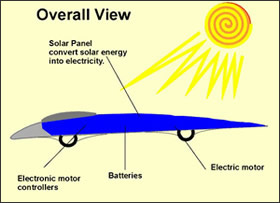April 2003 |
|
This summer, over two months, Marcelo da Luz and his Power of One (Xof1) team plan to travel across Canada and back: over 16,000 km (8,800 miles) total. Which wouldn't be all that remarkable, except that they plan to do it all in a solar car — a vehicle that uses about as much electricity as a toaster, and emits no harmful greenhouse gases.
While the primary goal of the expedition is to increase public awareness of the use of clean and sustainable energy, the journey will also set a new world record for distance travel by solar car. And as de Luz states on his Web site (www.xof1.com):
The challenge of the project alone motivates us. Constructing the car, the distance to cross, the diverse weather and terrain, beautiful and unique landscapes across the route… It will be a great adventure. The team plans to leave Toronto on June 16, 2003; arrive in St. John's, Newfoundland on June 30; drive cross-country to Vancouver by August 4; then head back to Toronto by August 18. View Video.
|
|
|
Records are made to be broken
Marcelo da Luz is not a newcomer to the world of solar car design and driving. In fact, the seeds of this project go back to 1987. After viewing the first World Solar Challenge race that year, da Luz became inspired to build his own solar car and participate himself. From that start, his plans have evolved over time.
In the summer 2000, da Luz was involved in the Suntrek 2000 project, in which 15 students from Queen's University in Kingston, Ontario traveled from Halifax, Nova Scotia to Vancouver, British Columbia. They traveled 7044 km (4377 miles) in just over a month, setting a world distance record in the process. Da Luz played the role of official independent observer, validating and documenting the team's record-breaking expedition. |
 |
Two years later, in the Australian summer of 2002, a group from Australia traveled around that country in a solar car. Their 13,054 km journey over 24 days broke the Canadian record. To this point, that record stands unchallenged.
The Xof1 team hopes to change all of that this summer with the car they are designing. And da Luz points out that "other world records will be disputed along the way, such as the solar car driver that spent the most time driving." |
Solar car technology
If you're not steeped in this world, you may not realize how advanced solar car technology has become. But with World Solar Challenges held annually, the Xof1 team has a wealth of design models to draw on. These are the basic components of a solar car. |
 |
The upper portion of the car is covered in photovolvaics cells (solar cells). The solar cells convert sunlight into electricity. The electricity is then stored in batteries that power an electric motor and drive the car.
Without the battery, the performance of the car is seriously compromised. The battery supplements the electricity used by the car. For example, a solar car using efficient solar cells may go as fast as 70 km/h under direct sunlight alone and can reach speeds of up to 120 km/h with help of the battery. However, under cloud, rain, tunnel, or going up hill without the battery, its speed may only reach 10 or 20 km/h. |
|
The solar car operates more efficiently than a gas-powered vehicle because it doesn't have to accommodate a grid (radiators) to cool off the motor. In spite of the solar car sometimes being wider and longer than a normal car, it has far less air resistance (drag) due to its low profile. Some cars have rear-mounted cameras instead of a rear mirror to minimize air drag.
Even though solar car tires are not commercially available, some manufactures make them. The solar car tires have a rolling resistance of about 2.5 kg/p/ton compared with 11 or 13 for regular car tires. (It should be noted that solar car tires are designed for races, while regular car tires are optimized for regular, daily use.)
Over the years, a number of shapes have been used for solar cars. So far, unlike Formula 1 (for example), no single shape has emerged as the best one to use. This makes solar car events even more interesting to watch.
As technology advances, so does the variety of materials used in the fabrication of the solar cars. Some of the most common materials used are fiber glass, carbon fiber, and kevlar. Some teams have even used bamboo, balsa wood, and rice paper as building materials for their cars!
Want to help make history?
The Xof1 team can use your help! If you are an electrical or mechanical engineer with an interest in solar technology, the team would love to hear from you. Find out more at their www.xof1.com Web site, or by emailing them at solarcar@xof1.com. You would be joining an illustrious group of sponsors that includes ASCION Industries, Electrovaya, Shell Solar, and Siemens.
|